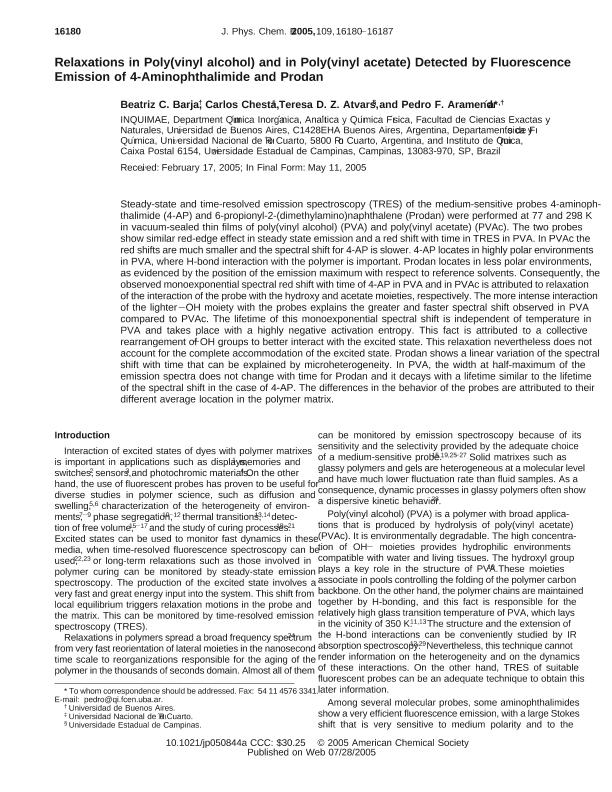Artículo
Relaxations in Poly(vinyl alcohol) and in Poly(vinyl acetate) Detected by Fluorescence Emission of 4-Aminophthalimide and Prodan
Fecha de publicación:
08/2005
Editorial:
American Chemical Society
Revista:
Journal of Physical Chemistry B
ISSN:
1520-6106
e-ISSN:
1089-5647
Idioma:
Inglés
Tipo de recurso:
Artículo publicado
Clasificación temática:
Resumen
Steady-state and time-resolved emission spectroscopy (TRES) of the medium-sensitive probes 4-aminophthalimide (4-AP) and 6-propionyl-2-(dimethylamino)naphthalene (Prodan) were performed at 77 and 298 K in vacuum-sealed thin films of poly(vinyl alcohol) (PVA) and poly(vinyl acetate) (PVAc). The two probes show similar red-edge effect in steady state emission and a red shift with time in TRES in PVA. In PVAc the red shifts are much smaller and the spectral shift for 4-AP is slower. 4-AP locates in highly polar environments in PVA, where H-bond interaction with the polymer is important. Prodan locates in less polar environments, as evidenced by the position of the emission maximum with respect to reference solvents. Consequently, the observed monoexponential spectral red shift with time of 4-AP in PVA and in PVAc is attributed to relaxation of the interaction of the probe with the hydroxy and acetate moieties, respectively. The more intense interaction of the lighter -OH moiety with the probes explains the greater and faster spectral shift observed in PVA compared to PVAc. The lifetime of this monoexponential spectral shift is independent of temperature in PVA and takes place with a highly negative activation entropy. This fact is attributed to a collective rearrangement of -OH groups to better interact with the excited state. This relaxation nevertheless does not account for the complete accommodation of the excited state. Prodan shows a linear variation of the spectral shift with time that can be explained by microheterogeneity. In PVA, the width at half-maximum of the emission spectra does not change with time for Prodan and it decays with a lifetime similar to the lifetime of the spectral shift in the case of 4-AP. The differences in the behavior of the probes are attributed to their different average location in the polymer matrix.
Palabras clave:
polymer
,
PRODAN
,
4-aminophthalimide
,
relaxation
Archivos asociados
Licencia
Identificadores
Colecciones
Articulos(CIBION)
Articulos de CENTRO DE INVESTIGACIONES EN BIONANOCIENCIAS "ELIZABETH JARES ERIJMAN"
Articulos de CENTRO DE INVESTIGACIONES EN BIONANOCIENCIAS "ELIZABETH JARES ERIJMAN"
Citación
Barja, Beatriz Carmen; Chesta, Carlos Alberto; Atvars, Teresa D. Z.; Aramendia, Pedro Francisco; Relaxations in Poly(vinyl alcohol) and in Poly(vinyl acetate) Detected by Fluorescence Emission of 4-Aminophthalimide and Prodan; American Chemical Society; Journal of Physical Chemistry B; 109; 33; 8-2005; 16180-16187
Compartir
Altmétricas




